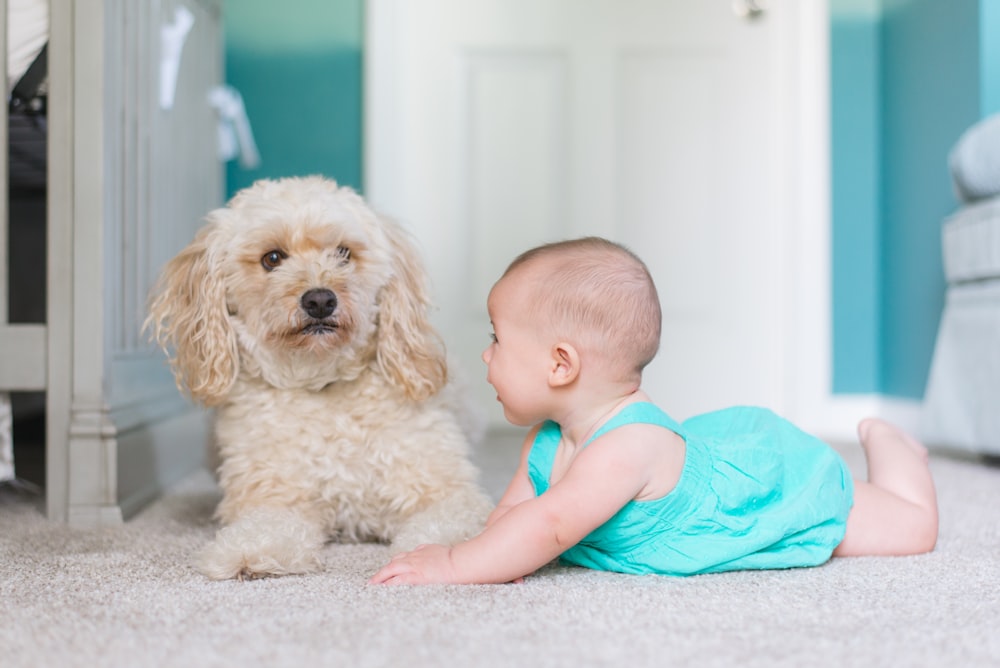We all love our fur babies. They share our homes and become regular members of our families, usually for many years. But what happens when we bring home a real baby? Our pets were there first, after all, and they may not understand why there’s suddenly a newcomer in their space. How can we ensure that our human babies will successfully mingle with our fuzzy ones? You want them to not only get along but also grow to love each other as much as you love them. Here, Crème de la Crème of Lone Tree, Colorado, offers you some tips for introducing a new baby to your pets.
Getting Ready

Photo via Unsplash by Omar Valenzuela using Unsplash License
Use the months leading up to your new baby’s arrival to prepare your pets for what’s coming. This may involve working to change your pets’ habits, introducing them to a new routine, or trying to ease the transition by slowly altering their environment.
Behavioral Changes
For starters, now is the time to try to break your pets of any habits they have that aren’t baby-friendly. This could be a tendency to bark, growl, hiss, or jump on people. Even if these habits come with only the best intentions, such as a dog who barks when he’s happy to see you or a cat who likes to jump up in your lap, certain animal behaviors can be upsetting or even dangerous for a baby.
However, it may not be easy for your pets to readjust their behaviors. If you’re finding it particularly difficult to teach an old dog new tricks, you may need to seek the help of professional dog trainers in the Thornton area.
Routine Changes
You’ll also want to show your pets that their routine will likely change. For example, if your dog is used to going for a walk right at 8 a.m., and that’s going to be the baby’s feeding time, try to get them used to a different walking time before the baby even comes home. Start taking them out at a new time well in advance.
Another adjustment to your pet’s routine could be how much time you’ll have to spend with them. Babies take up a lot of time, so you may have less time to devote to playing catch with Fido or cuddling with Whiskers. If you anticipate that this will be the case, try to gradually reduce your quality time with your pets as the baby’s arrival nears so that the changes won’t seem so abrupt to your pets later.
Environmental Changes
Prepare your pets for a soon-to-be very different home environment. Teach them that specific spaces, such as the nursery or changing table, are now off-limits. Make space for the baby—you may need to move the dog bed to a different room or find a new spot for the litter box.
Try to get your pets used to the baby itself, even before there is one. For example, many experts suggest carrying around a doll so your pets can adjust to you regularly having a baby in your arms. They also recommend playing a recording of a baby crying to acclimate your animals to the sound. You may even try taking your dog out for his walk while pushing a stroller.
Once the baby is born and before you bring them into the house, consider bringing home something that the baby has touched so that your pets can become familiar with the new baby’s smell before they even meet them.
Bringing Home Baby
Once it’s time to bring home your new bundle of joy, you’ll want to introduce the baby to your pets as quickly as possible. Here are some tips to ensure that your baby’s “meet cute” stays cute and doesn’t devolve into an unpleasant or even dangerous situation.
Making First Introductions
When it’s time to introduce your baby to your pets, make sure that you have another adult there to help watch the animals while you hold the baby. Keep dogs on a leash, and ensure that your pet is calm and comfortable before you bring the baby into the picture. Let your animal sniff and discover his new companion and reinforce any positive behavior so that in his animal brain, baby equals good. If a kitty runs off and hides under the bed when presented with the tiny human stranger, this is entirely normal.
Never Leave Them Alone Together
When your pets and baby are in the same room, make sure that someone is always around to keep an eye on their interactions. Remember that animals can be unpredictable, and even the cuddliest pet may show unexpected signs of aggression. This is especially true if your pets feel threatened. So, just as you’ve been trying to train your pets to play nice with the baby, make sure also to teach your baby to be good to your pets. That means no tugging on tails or pulling of ears, for instance. Reward both baby and animal when they treat each other well.
If your pet growls or hisses at the baby, separate them immediately. Then try using a leash or muzzle or get your pet into an obedience program to fight aggression. Thornton has a lot of top-notch obedience schools that will teach your best buddy to be better behaved.
Don’t Neglect Your Pets
Your baby is surely your number one priority now, but don’t forget to give some attention to your pets still. Spend some time one-on-one with them when they can be the focus of your full attention, but also when the baby is around and awake. If you want a happy pet-baby relationship, you don’t want your animals to associate the baby with being ignored or even punished.
Beware Of Pet and Baby Supplies
Many toys and supplies can be toxic or pose choking hazards to babies and animals. Dogs could swallow pacifiers, baby bottle nipples, or baby toys. Diaper rash ointment may also be poisonous to animals. Similarly, many pet medications should never come in contact with your baby. Watch that your child doesn’t try to put a chew toy or bone in their mouth.
Thanks to Crème de la Crème, you now have some valuable tips for introducing a new baby to your pets. These should help guarantee a smooth transition from a household with just pets to one that includes animals, a new baby, and plenty of love. Do you have any other suggestions that we didn’t mention here? Do you know of any great animal training programs? If so, please let us know!
